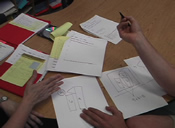View clips of two colleagues also teaching problem solving at Slater School... Video of conversations
with these teachers
|
Scaffolding problem solving, First Grade
This series are clips are examples of what is involved when attempting to build understanding among students who were initially confused by a problem.
|
Clip 1:
Create a visual model of the problem |
Sometimes more than one diagram can fit a given situation. One person might think of a situation as parts-and-total while another person might see the same situation as change. Don't be too inflexible about which diagram is the most appropriate for a given situation, and remember that many situations are not suitable for any diagram. |
|
play
|
Quicktime Player
high • low
get plugin |
Windows Media
high • low
get plugin |
|
Using "5 steps" to problem solve, Second Grade
This series are clips are examples of how a second grade teacher solves a word problem with her class using each step of the QDPA√ system.
Clip 1:
Agreeing upon the Question: What it is that we want to find out
|
The class determines the actual question embedded in this "fat pig" problem. |
|
play
|
Quicktime Player
high • low
get plugin |
Windows Media
high • low
get plugin |
|
Clip 2:
Make the solving method an observable action
|
|
Most problems can be solved in more than one way. A change-to-more, for example, might be solved by addition, by counting up mentally or on a number grid, by acting out with counters, by drawing pictures, or in any number of other ways. |
play
|
Quicktime Player
high • low
get plugin |
Windows Media
high • low
get plugin |
|
Clip 2:
Listing the Data: The information (often numbers) provided in the problem
|
|
Then they find and list the data. |
play
|
Quicktime Player
high • low
get plugin |
Windows Media
high • low
get plugin |
|
Clip 3:
Reiterate and/or check the sensibility of the answer
|
Try to keep the context of the problem as a constant thread during a problem solving session. If the problem is about two students and who has more cookies, use the names of the children, the terms more and less, and include the main points of the question throughout as well as the unit (that would be cookies in this case). |
|
play
|
Quicktime Player
high • low
get plugin |
Windows Media
high • low
get plugin |
|
Clip 3:
Developing a Plan: What we need to do with the data to solve
|
They discuss and attempt a plan, choosing subtraction. |
|
play
|
Quicktime Player
high • low
get plugin |
Windows Media
high • low
get plugin |
|
Clip 4:
Attach an equation to the problem
|
|
The equation (or number model) need not reflect how the problem was solved: A child might write "8 + 3 = 11" for a change-to-more problem that she solved by using counters. Often several number model can fir a single situation. Connecting number models to situations can help children undersatnd the arithmetic operations and the symbols for those operations. |
play
|
Quicktime Player
high • low
get plugin |
Windows Media
high • low
get plugin |
|
Clip 4:
Determining an Answer: The outcome of the plan
|
|
Feeling uncertain about the answer at first, they keep working and finally settle on the outcome. |
play
|
Quicktime Player
high • low
get plugin |
Windows Media
high • low
get plugin |
|
Clip 5:
Bridge newly accomplished work to easily confused related content
|
Often there are golden opportunities when it seems that a particular situation and math concept become clear to students. Always ask yourself as a teacher, "What is this similar to?" "What can I compare this to in order to build understanding?" or "How can make sure that I can refer back to this moment in my class later when the kids are confused?" |
|
play
|
Quicktime Player
high • low
get plugin |
Windows Media
high • low
get plugin |
|
Clip 5:
Checking our work: Looking carefully to see if the answer is correct
|
The class identifies a computation error while checking their work. |
|
play
|
Quicktime Player
high • low
get plugin |
Windows Media
high • low
get plugin |
|

Teacher to teacher conversations....
|
Katharine Wilson agrees to trade videos of lessons and discuss how I can best prepare my first graders for her second grade math program.
|
play
|
|
|
|
Matt Ellinger and I really get into the nitty gritty of comparison. We address the question of which kind of comparison problem is best when in first grade? And also, why use two-step problems with comparison?
|
play
|
|
|
|
|
| |